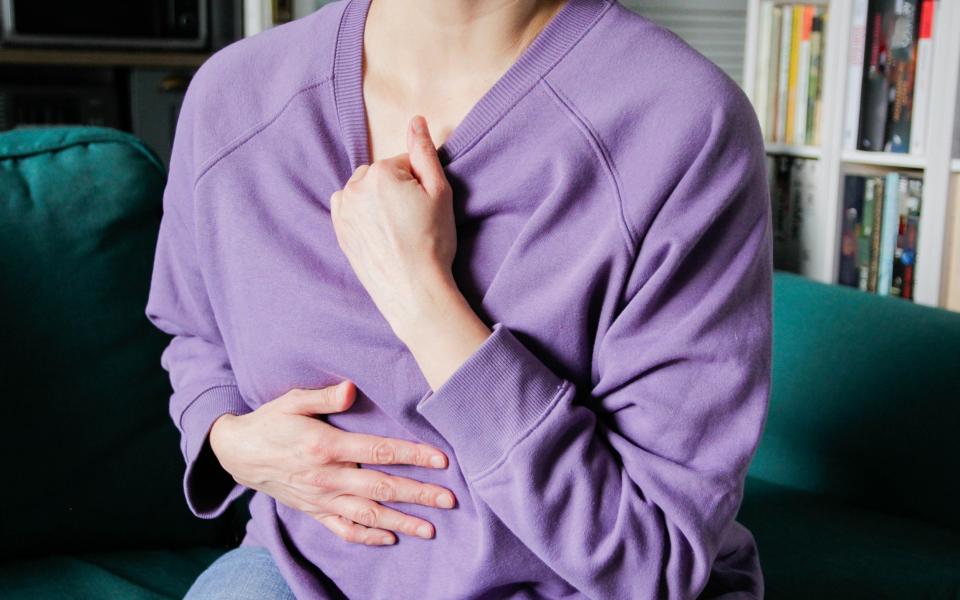Everything you need to know about hot flushes

Phew! I’m not saying ‘phew’ because I’m hot (although I often do feel like I am melting around the edges). It’s more a ‘phew’ with a sigh of relief. Because some medical genius somewhere has come up with a new drug that prevents menopausal hot flushes. Veoza, also known as fezolinetant, has been approved by US regulator, the Food and Drug Administration, and is being hailed by many as a ‘game-changer’.
Currently a prescription-only, non-hormonal medicine, it is soon to be available privately here from January, with a review for potential use on the NHS in July 2024. The private cost has been set at £44.80 for 28 days worth of 45mg tablets.
Hot flushes are no joke for women of a certain age. I know because I’ve raged through them. One minute you are merrily getting on with your day, then without a hint of warning, you feel that furnace starting in your legs, sometimes even in your feet. The razor-sharp heat travels up your body, through your belly until it reaches your chest and head, almost blasting its way out of your what-the-hell brain.

You feel like someone is attempting to burn you at the stake as your face turns the vermillion shade of a Man United shirt, and rivulets of sweat spill down your flaming cheeks with the same commitment as the Trevi fountain. I once remember, I had to leave a party because I was so distracted by the effects of a hot flush, I lost the power of speech. And the silk shirt I was wearing had a rapidly spreading dark patch that resembles a map of Canada across my very sodden back. ‘Humiliating’ isn’t a strong enough word to describe it.
So could fezolinetant be the answer? The drug has been given the thumbs up here by the Medicines and Healthcare Products Regulatory Agency (MHRA). And for women who are not suited to HRT because of a history of breast or ovarian cancer, blood clots or high blood pressure, fezolinetant may be life-changing.
Julian Beach, the interim executive director of healthcare quality and access at the MHRA, told us: “Hot flushes and night sweats caused by menopause are common, and can have a significant impact on a woman’s daily life.We are therefore pleased to have authorised Veoza (fezolinetant) for hot flushes and night sweats caused by menopause via our reliance procedure. No medicine would be approved unless it met our expected standards of safety, quality and effectiveness and we continue to keep the safety of all medicines under close review.”
Dr Louise Newson, GP, menopause specialist and founder of menopause app, balance, is more sceptical. She says: “While fezolinetant is being reported as a promising non-hormonal option for treating menopausal symptoms, it will only target vasomotor (hot flush) symptoms which are not the commonest symptoms of the perimenopause or menopause. More worryingly, there is a lack of evidence on long-term (more than one year) efficacy and safety, and this drug has not been tested on all ages of menopausal women.”
Fezolinetant works by blocking a brain protein – neurokinin-3 – that controls body temperature in menopausal women. Clinical trials carried out earlier this year, involving women aged between 40-65, have shown that after 12 weeks of use, it reduced the frequency of hot flushes by about 60% in those with noticeable symptoms.
Louise Newson adds: “Just remember, this drug does not replace oestrogen and so will not improve bone density, reduce inflammation and protect our brains and cardiovascular system from the effects of low hormones.”
Advocates, especially those who are averse to HRT, are excited by the possibility of no more waking up at 2am stuck to the duvet cover, but it is still early days for fezolinetant. Like all new ‘game-changing’ medicines, the jury is out.

What is a hot flush?
Up to 70% of women going through the menopause experience hot flushes. They typically feel temporary periods of intense heat in their upper body, arms and face. They can sweat more profusely and have flushed skin. Adrenaline, and exercise, can increase the intensity of a hot flush; dehydration can also occur, particularly if the weather is warm. It’s important to drink lots of fluids. Alcohol and caffeine can make symptoms worse, and so some menopausal women choose to avoid these.
What causes a hot flush?
Our body’s temperature is controlled by a section of the brain called the hypothalamus. Dr Penny Ward, GP and menopause specialist at Newson Health, says, “When a woman’s oestrogen levels start to fall in perimenopause and menopause, it causes disruption in this area, often resulting in hot flushes and night sweats.”
Paula Briggs, chair of the British Menopause Society and consultant in sexual and reproductive health at Liverpool Women’s NHS Foundation Trust, adds, “While low oestrogen levels are key in this process, not all women with low oestrogen will have hot flushes. Other factors involving compromised neurotransmitters can play a role, and research has linked gene variants in individuals to hot flushes.”
How long does a hot flush last?
A flush can last anything from a few seconds to several minutes. The overall duration of experiencing hot flushes tends to be between six months and a couple of years. But for many women, they can be significantly longer. Some women report having hot flushes into their eighties.
What does a hot flush feel like?
Mainly, there is a feeling of increased heat, flushing of the skin and sweating. Some women can feel fretful, distracted and out of sorts. Anticipating when a flush might happen, especially at inopportune moments, can cause fearfulness and agitation. Interference with sleeping patterns can have a continuing effect on mood and the ability to cope. Sufferers say they sometimes experience chills, palpitations and a lasting level of anxiety after a hot flush.
Why do hot flushes come on after eating?
Paula Briggs explains, “Although many women report this happening, the reason is not fully understood. But it may be linked with minor changes in core body temperature as we eat. Certain compounds within foods can also affect neurotransmitters, which influence the ability of the hypothalamus to regulate body temperature.” Spicy foods, sugary processed products, alcohol and caffeine are typical culprits.
How does fezolinetant work to stop a hot flush?
It selectively blocks a brain protein, called neurokinin-3, in the hypothalamus, the area of the brain that controls body temperature in menopausal women. Because fezolinetant is not a hormone drug, it does not replace oestrogen which diminishes greatly in menopausal women.
Does fezolinetant have any side effects?
As a relatively new drug, there have been limited studies on side effects. There is a possibility of diarrhoea, upset tummy, alteration in liver function and insomnia.

